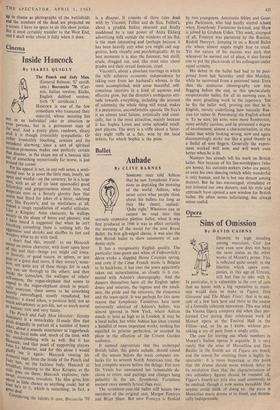Ballet
Aubade
By CLIVE BARNES
It has a recognisably English quality. The particular lime-green and white of Fedoroviteh's decor evoke a dappled Home Counties spring, and even if the Cesar Franck music is Belgian to its backbone, it has over the years apparently taken out naturalisation, so closely is it con- nected with Ashton's choreography. And the dancers themselves have all the English splen- dours and miseries, the bigness and the small- ness, the pride and the reticence, the eloquence and the team-spirit. It was perhaps for this same reason that Symphonic Variations, here most universally admired of Ashton's ballets, was almost ignored in New York, where Ashton stands at least as high as in London. It may be a local ballet, but while Ashton has since created a handful of more important works, nothing has equalled its pristine perfection, or usurped its place in the affection of the Covent Garden audience.
It seemed appropriate that this archetypal British ballet, this gentle aubade, should round off the season before the main company em- barks for its seventh North American tour, the last complete season before the deluge. For now De Valois has announced her lamentable de- cision to retire, and partings and changes hang palpably in the air, Symphonic Variations seemed more sweetly lyrical than ever.
The seventeen-year-old ballet still boasts two members of the original cast, Margot Fonteyn and Brian Shaw. But nOw Fonteyn is flanked
by two youngsters, Antoinette Sibley and Geor- gina Parkinson, who had hardly started school when Symphonic Variations dawned, and Shaw is joined by Graham Usher. This week, strangest of all, Fonteyn was partnered by the Russian, Rudolf Nureyev, jumping in on a Royal Ballet rite where almost angels might fear to tread, Yet the nature of his success was such that whenever he seemed out of place, it also forced one to put the place-cards of his colleagues under equal scrutiny.
His debut in the ballet had had to be post- poned from last Saturday until this Monday, while he recovered from a poisoned hand. Even then the strenuous choreography saw him flagging before the end, as this spectacularly unspectacular ballet, for all its seeming ease, is the most gruelling work in the repertory. Yet he fits the ballet well, proving not that he is English, merely underlining how basically Rus- sian (or rather St. Petersburg) the English school is. To be sure, his arms were more flamboyant, more artfully careless, and he presented a degree of involvement, almost a characterisation, in this ballet that while looking wrong, now and again disconcertingly sticks out like a good thumb in a fistful of sore fingers. Generally the experi- ment worked well now, and will work even better when he is fit.
Nureyev has already left his mark on British ballet. Not because of his fan-worshippers (who are bores), his curiosity-seekers (who are pests), or even his own dancing (which while wonderful is only human, and he is but one dancer among dozens). But he has encouraged, stimulated or just irritated our own dancers, and his style and approach have opened a new window for British ballet. He often seems infuriating, but always seems useful.


































 Previous page
Previous page